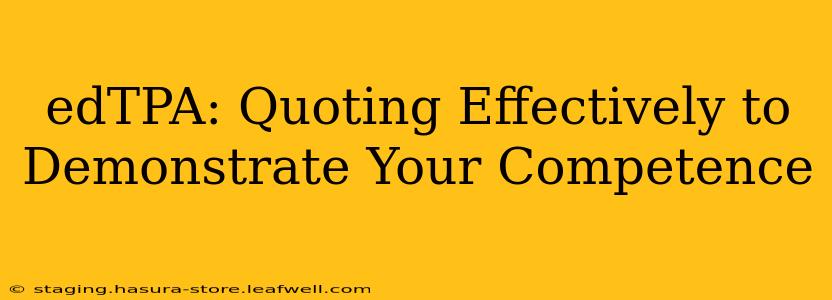The edTPA (Educator Performance Assessment) is a rigorous assessment designed to evaluate your teaching skills. One crucial aspect often overlooked is the effective use of quotes within your edTPA portfolio. Successfully quoting evidence—from lesson plans, student work, and your reflections—demonstrates your ability to analyze teaching practices and student learning critically. This article will guide you through the art of quoting effectively for your edTPA, helping you showcase your competence and achieve a high score.
Why is Effective Quoting Important in the edTPA?
The edTPA emphasizes evidence-based reflection. Quoting directly from your lesson plans, student work samples, and your own reflective writing allows you to concretely support your claims. Without strong evidence, your analyses lack weight and credibility. Effective quoting is the bridge between your observations and your insightful interpretations, showcasing your analytical thinking and your understanding of teaching and learning. It's not merely about including quotes; it's about strategically selecting and contextualizing them to bolster your arguments.
How to Quote Effectively in Your edTPA
Here's a step-by-step guide to mastering the art of quoting within your edTPA:
1. Select Relevant and Meaningful Quotes
Don't just include any quote; choose excerpts that directly support your analysis. The quote should clearly demonstrate a specific point you are trying to make. Consider the overall narrative of your edTPA and how the quote fits into the larger picture. Ask yourself: "Does this quote directly illustrate my argument?" If not, find a more suitable excerpt.
2. Contextualize Your Quotes
Never drop a quote into your writing without proper introduction and explanation. Provide sufficient context before the quote, explaining the situation, the lesson, or the student's work from which the quote is taken. After the quote, analyze its significance; explain why you chose this particular quote and what it reveals about your teaching or your students' learning. This analysis shows your understanding and strengthens your argument.
3. Use Accurate and Complete Quotes
Ensure your quotes are precisely transcribed from the original source. Any alteration, even a minor one, should be indicated using brackets "[ ]" or ellipses "...". Maintain grammatical accuracy. If the grammar in the original source is poor, you might need to explain this in your analysis.
4. Use Short, Focused Quotes
Avoid lengthy quotes. Select concise excerpts that convey the most important information. A shorter, well-chosen quote is usually more impactful than a longer, rambling one.
5. Properly Cite Your Sources
Always cite your sources using a consistent citation style (e.g., APA, MLA). This demonstrates academic honesty and strengthens your credibility. The edTPA guidelines should specify the required citation format.
Frequently Asked Questions (PAA)
How many quotes should I include in each section of my edTPA?
There's no magic number. Focus on quality over quantity. Include only the quotes necessary to effectively support your arguments. Prioritize strong, insightful analysis over simply piling up quotes.
What types of evidence should I quote in my edTPA?
You should quote from various sources, including your lesson plans, student work samples (written assignments, projects, artwork, etc.), classroom observations, and your own reflective writing. A diverse range of evidence demonstrates a comprehensive understanding of your teaching and learning process.
What if the student work samples contain grammatical errors or informal language?
This is perfectly acceptable. You should quote the student work exactly as it appears. However, in your analysis, you can acknowledge the presence of grammatical errors or informal language, and then explain how these aspects inform your understanding of the student's learning.
Can I paraphrase instead of using direct quotes?
While paraphrasing can be useful, direct quotes often provide stronger evidence, especially when demonstrating specific student language or thought processes. Strive for a balance between direct quotes and paraphrasing.
How can I ensure my quotes effectively showcase my teaching competence?
By carefully selecting quotes that directly demonstrate your planning, instruction, assessment, and student learning outcomes, your competence in addressing these domains will become clear. Focus on showcasing the positive impact of your teaching strategies.
Conclusion
Mastering the art of quoting effectively is crucial for success in the edTPA. By carefully selecting, contextualizing, and analyzing quotes from your teaching materials and student work, you can build a strong, compelling narrative that showcases your competence as a teacher. Remember to focus on quality analysis over quantity of quotes, and ensure your writing is clear, concise, and well-supported by evidence. Good luck!

